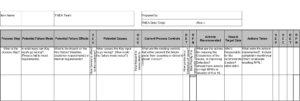How to use FMECA to drive reliability improvements in your organization
 An important part of the Reliability Centered Maintenance process, or used as a standalone approach for less critical assets; the Failure Mode Effect Criticality Analysis is vital reliability tool. However, a large percentage of organizations do not take advantage of the tool during the design phase of the asset, or to develop the maintenance strategy once the asset is installed.
An important part of the Reliability Centered Maintenance process, or used as a standalone approach for less critical assets; the Failure Mode Effect Criticality Analysis is vital reliability tool. However, a large percentage of organizations do not take advantage of the tool during the design phase of the asset, or to develop the maintenance strategy once the asset is installed.
Why this tool is not used often, I am not sure, but may be due to the initial experiences that many of us have had with an FMEA/FMECA. This initial experience usually includes being brought into a meeting room for days on end to review every single component of the asset, or process. This is usually a painful process and is not the way that the FMECA should be used. The FMECA should be used for top 20% to 60% of assets with RCM is reserved for the top 20%.
Another reason why the tool may not be used is that there is not enough awareness of it. This post will hopefully provide some additional insights and awareness of the FMECA.
What is an FMECA?
The FMECA is a systematic technique that guides a review of a system, sub-system, or item for all potential failure modes. This technique takes into the account the probability of a functional failure occurring and the consequences of the functional failure. The criticality potion of the technique allows the team to place a value or rating on the specific failure mode, allowing for evaluation and prioritization of the failure effect.
The FMECA utilizes some specific terminology that you may be familiar with;
- Criticality – a measure of the consequence and probability of occurrence
- Failure Effects – the results or consequences of a functional failure has on the asset or system
- Failure Mode – the manner in which the failure is observed (Object, Damage, Cause)
- Failure Mechanism – is the cause of the failure mode
- Severity – the consequences of the failure mode.
The FMECA is a detailed analysis of an asset down to the component level. All components are reviewed for failure modes, the effect of the failure mode, and the probability that the failure mode will occur. For each one of the failure modes, corrective or preventative action can be determined based on the criticality of the failure mode (start with the highest risk number and work down). These corrective and preventative actions may be design changes, procedural changes, training and maintenance activities.
What is an FMECA Used for?
The FMECA can be used in different stages of the asset lifecycle. The purpose is still the same, but the focus on the outcomes may change depending on the stage in which it is used;
- Design FMECA is used when the asset is still in the design phase. It provides the organization the opportunity to tweak the design of the asset to improve the reliability and maintainability of the asset while it is still cost-effective. Often, once the asset is built, design changes are not easily achieved.
- System FMECA is used when the asset is installed. The primary focus is to develop an integrated approach to asset reliability. This integrated approach leverages both operational and maintenance staff to perform the right basic care, maintenance, and procedural activities to ensure maximum reliability from the current design.
Remember the inherent reliability of the asset is based on the design, and no amount of maintenance will improve that inherent reliability. So be sure to use the Design FMECA to improve the inherent reliability, before the asset is built.
What Should You Have in Place for an FMECA?
Before starting an FMECA, there are certain items and people that should be available. This will ensure the process operates smoothly and is not painful as many of our first FMECAs were.
- Is there a functional specification available for the asset indicating all primary and secondary functions?
- Is an experienced facilitator available for the analysis?
- Is there a block diagram of the system?
- Are the consequences, probability, and detectability scales clear and defined?
- Have all staff been provided with awareness training on FMECA?
- Have ground rules been established for the analysis (these may include when to part a discussion, length of sessions, etc.)?
This list may be expanded upon based on the experience of the facilitator or organization, but provides a starting point.
Steps of an FMECA
The FMECA is a sequential process, meaning that the steps must be completed in order. To complete an FMECA, the following steps are performed;
- Document System Functions (Primary & Secondary)
- Define potential failure modes impacting primary & secondary functions
- Document failure effects for each failure mode
- Document the cause of each failure mode
- Document the current controls in place for each cause
- Identify the probability of the failure mode occurring for each cause
- Identify the severity of the failure of the system
- Identify the detectability of the failure; this is who likely the current controls will detect the potential failure before it becomes a functional failure
- Calculate the RPN (risk priority number) by multiplying the values from the probability, severity and detectability columns
- Recommend actions to reduce the RPN.
- Determine what actions will be implemented based on financial or technical constraints.
- Determine the new probability, severity, and detectability based on the actions to be implemented
- Document the new RPN
- Document the individual who is responsible for implementing the actions.
It is important to note that there may be many failure modes per function and many causes for each failure mode. Be sure to record all relevant (meaning, likely to occur or has occurred in the past) failure modes and causes. There is no need to record everything that could potentially occur unless there is a specific need to. Often, the relevant failure modes and causes are enough for most organizations.
Conclusion
The FMECA is designed to eliminate failures from occurring using a closed loop system. Yes, it is a living document that needs to be updated based on new learnings. The FMECA process should focus on the;
- Elimination of critical failure modes
- Detailed analysis of each failure (RCA process) to prevent future occurrence and updating of the current FMECA
- Implementation of recommendations from RCA and FMECA
- Track trends to evaluate the effectiveness and improvement.
Using an FMECA is critical to the success of any reliability improvement program and hence, the organization. What is stopping you from using the FMECA? If you need assistance in understanding and applying the FMECA and other reliability tools, please contact [email protected] for additional information.
Eruditio offers the unique iBL (inspired blended learning) curriculum that separates their training apart from all others.
I’m James Kovacevic
Principal Instructor at Eruditio
Where Education Meets Application
Follow @EruditioLLC
Follow @ReliableJames
References;

